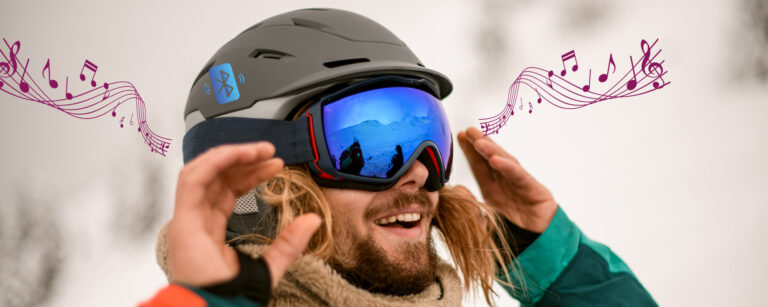How To Choose Ski Goggles – Complete Guide
The proper ski goggles are critical to a good day on the slopes. When choosing what to wear on the slopes, you want ski goggles that protect your eyes from the sun, wind, cold and other elements while out on the slopes. You want them to provide good definition in low-light conditions, not fog up, and provide the perfect fit for your head and face at the ski resort.
Our guide on how to choose ski goggles will show you the critical features you need to consider when buying your next pair of goggles.
Goggle Lens shape
Goggles have several different lens shapes, each with its benefits. The most common are cylindrical lenses, which provide excellent peripheral vision and provides an unobstructed view from the side. Spherical lenses are curved, giving you better protection from the elements and providing a wider field of vision.
Spherical Lenses
A spherical lens is curved in two directions, giving you a wide field of vision and better protection from the elements. The spherical shape also helps reduce fogging and is often used for higher-end models.
Cylindrical Lenses
A cylindrical lens is flat in one direction and curved in the other. Cylindrical lenses are lighter and provide excellent peripheral vision.
Toric Lenses
A toric lens is curved in both the x and y directions but with less curvature in the y direction than a spherical lens. The shape more closely follows the face and gives better optics and clarity. Toric lenses also reduce glare and improve depth perception.
Goggle Lens Type
There are several different types of goggles lenses with additional features.
Interchangeable Lenses
Interchangeable lenses allow you to swap out the lens to adjust for different light conditions. This is crucial in high-altitude areas, where the sunlight can be very intense. Some models come with several lenses so that you can choose the best one for any condition. They have different connection methods, including magnets, snaps, and clips.
Double Lenses
Double-lens goggles use two layers with a small gap to prevent the goggles from fogging. Most double lenses are made of durable polycarbonate and can withstand impact.
OTG Goggles
OTG or over-the-glasses goggles are meant for people who wear prescription glasses. They fit over glasses and provide a comfortable, secure fit. OTG goggles have larger frames than regular goggles.
Goggle Lens Tints
The lens tint is one of the most important factors when choosing a pair of goggles. Ski goggles come in different shades, including light, medium and dark. Light-tint lenses are best for cloudy days or night skiing, while dark-tint lenses are great for bright, sunny days.
Lens Tint and Visible Light Transmission
The tint of the lens also affects how much light can pass through it, known as Visible Light Transmission (VLT). A lower VLT allows less light to pass, while a higher VLT lets in more light. A higher VTL is best for overcast days, while a lower VTL is better for sunny or snowy days.
Lens Color
Lens color is essential for contrast. It can help you pick out terrain features and follow the contours of the snow better. Different colors make different parts of the light spectrum stand out more clearly, so choose a color that works best for how and where you ski.
Photochromic Lenses
Photochromic lenses automatically adjust their tint depending on how bright it is. They darken when exposed to sunlight and lighten when it is darker. Photochromic lenses can be either spherical or cylindrical, offering excellent visibility in all light conditions.
Goggle Lens Coatings
Goggles have several different lens coatings that can improve their functionality.
Mirrored Lenses
Mirrored lenses use a protective coating to reduce glare and improve visual acuity in bright light. The coating also protects the lens from scratches, dirt, and other damage.
Polarized Lenses
Polarized lenses reduce glare and improve visibility. They contain a special coating that filters out light reflecting off the snow and ice, resulting in improved detail and enhanced contrast. Polarized lenses can also help reduce eye strain when skiing on bright days.
Anti-Fog Coating
Many goggles come with an anti-fog coating that helps prevent the lenses from fogging. The coating helps reduce moisture build-up and keeps your vision clear.
Ventilation
Good goggle ventilation is critical for keeping your vision clear. Look for goggles with vents on the top and bottom of the frame to allow air to flow freely and reduce fogging.
Choose The Right Goggle Size For You

Goggles come in various sizes and shapes to fit different face shapes. It is essential to find a pair that fits comfortably, so try on several pairs before buying. Ensure the goggles do not pinch or press too hard against your face.
How to know if your goggles fit properly
Your goggles should fit snugly against your face but not too tight. They should not slip off or let in any air. If you have the right size, the foam on the edges of the frame will seal against your skin and block out light. Your goggles should also be comfortable enough not to pinch when you move your head.
Goggle Frame Sizes
Most goggles come in multiple frame sizes. Smaller frames are great for people with smaller faces, and medium or large frames work best for those with medium to large faces. Check the recommended manufacturer sizing and try the goggles on in a store before you buy.
Asian Fit Goggles
Also known as Universal Fit or Low Bridge Fit goggles, this specialized eyewear offers an additional layer of foam padding to create a snug fit for those with lower nose bridges.
Helmet Compatibility
Most ski helmets are compatible with goggles. The brim of the helmet and the top of the goggles should align correctly with no goggle gap. Ski and snowboard goggles may also have a rubberized backstrap that fits around the helmet and prevents it from slipping.
How to Stop Your Ski & Snowboard Goggles From Fogging
Ski or snowboard goggles fogging up is always a problem — goggles fog when moisture gets trapped between the lens and your face. The best way to prevent fogging is to prevent moisture from getting inside your goggles. If moisture does get inside, try to vent the goggles. Put them on your helmet briefly while skiing, or hold them away from your face. If there is too much moisture, you may need to head back into the chalet and dry them using a heater.
Ski & Snowboard Goggle Care
A good ski goggle is an investment and can last for years if well taken care of. Store them in a safe, dry place, and avoid tossing them around or leaving them in direct sunlight. Clean the lenses with a soft cloth or the goggle bag provided. Use lens cleaner if necessary but avoid using anything abrasive that could damage the coating. Use a goggle sock to protect your goggles when you are not using them.
FAQ
What color lens is best for skiing?
Different lens colors can provide various benefits. For most skiing, a yellow or rose-tinted low-light lens offers the best visibility and contrast. For bright days, you should look for a polarized lens that filters out light reflecting off the snow and ice.
What Are The Best Low Light Lenses?
Low-light lenses improve visibility in flat and low-light conditions. They have a yellow or rose tint that enhances contrast, increases depth perception, and improves visual acuity. Low-light lenses also reduce glare from snow and ice, making them ideal for skiing on cloudy days.
How do I know what size ski goggles to get?
Goggles come in different sizes and shapes to fit different face shapes. It is essential to find a pair that fits comfortably, so try on several pairs before buying. Check the manufacturer’s sizing chart and try the goggles on in a store before you buy.
How to choose ski goggles?
When choosing snow goggles, you should consider how they fit, the lens type and tint, how well they ventilate, and how compatible they are with your helmet. Try different goggles before buying to ensure they are comfortable and provide proper visibility and protection.
Do you want high or low VLT in goggles?
VLT stands for visible light transmission and refers to how much light can pass through the lens. Generally, low VLT lenses are better for sunny days, while higher VLT lenses are best for flat or low-light conditions. Different manufacturers will have different recommendations for their goggles, so read the manufacturer’s guide before making a purchase.
How Many Goggles or Lenses Do You Need?
For most skiers, a single pair of goggles with a single lens will suffice. A generalized lens covering most light conditions is a good starting point. If you ski in varying light conditions, consider investing in a pair of goggles with interchangeable lenses. I recommend purchasing a low-light lens for darker days and a dark lens for brighter days. That way, you can easily switch lenses depending on the conditions.
Final Thoughts
Choosing the right ski and snowboard goggles is vital for any skier or snowboarder. Make sure to find a pair that fits comfortably, provides good visibility, and offers adequate protection from wind, snow, and ice. Remember, care for your goggles, and they will last you many seasons.
See you in the mountains!








